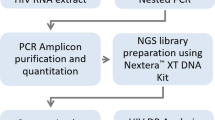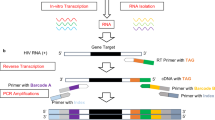Abstract
We developed a highly sensitive parallel allele-specific sequencing (PASS) assay to simultaneously analyze a large number of viral genomes and detect minor drug-resistant populations at ∼0.1–0.01% levels. Using this assay on samples from individuals infected with human immunodeficiency viruses (HIV), we successfully detected and quantified minor populations of drug-resistant viruses and performed linkage analysis of multiple-drug resistance mutations. This assay may serve as a useful tool to study drug resistance in HIV and other infectious agents.
NOTE: In the supplementary information initially published online to accompany this article, the image for patient 200371 in Supplementary Figure 6 was incorrect. This panel was replaced. The error has been corrected online.


Similar content being viewed by others
Change history
18 January 2007
In the supplementary information initially published online to accompany this article, the image for patient 200371 in Supplementary Figure 6 was incorrect. This panel was replaced. The error has been corrected online.
References
Johnson, V.A. et al. Top. HIV Med. 13, 125–131 (2005).
Charpentier, C. et al. J. Virol. 78, 4234–4247 (2004).
Mitra, R.D. et al. Proc. Natl. Acad. Sci. USA 100, 5926–5931 (2003).
Zhu, J., Shendure, J., Mitra, R.D. & Church, G.M. Science 301, 836–838 (2003).
Hirsch, M.S. et al. Clin. Infect. Dis. 37, 113–128 (2003).
Petropoulos, C.J. et al. Antimicrob. Agents Chemother. 44, 920–928 (2000).
Van Laethem, K. et al. J. Acquir. Immune Defic. Syndr. 22, 107–118 (1999).
Condra, J.H. et al. Nature 374, 569–571 (1995).
Metzner, K.J. et al. J. Infect. Dis. 188, 1433–1443 (2003).
Winters, M.A., Schapiro, J.M., Lawrence, J. & Merigan, T.C. J. Virol. 72, 5303–5306 (1998).
Fang, G., Zhu, G., Burger, H., Keithly, J.S. & Weiser, B. J. Virol. Methods 76, 139–148 (1998).
Liu, S.L. et al. Science 273, 415–416 (1996).
Merritt, J., Butz, J.A., Ogunnaike, B.A. & Edwards, J.S. Biotechnol. Bioeng. 92, 519–531 (2005).
Butz, J.A., Yan, H., Mikkilineni, V. & Edwards, J.S. BMC Genet. 5, 3 (2004).
Shendure, J. et al. Science 309, 1728–1732 (2005).
Acknowledgements
We thank Z. Camacho, A. Meade, B. Fee and X. Cao for their excellent technical assistance, J. Kirchherr for artwork, K. McGee for help in obtaining samples and clinical data, and B. Haynes for critical reading of the manuscript. This work was supported by grants from the US National Institutes of Health (RO1 GM 065057 to F.G. and K24 AI 01744 to J.A.B.), AIDS Clinical Trials Group (AI 136156 to J.A.B.), International Studies of AIDS-associated Co-infections (U01 AI062563 to J.A.B.), and Center for AIDS Research (P30 AI64518 to J.A.B. and F.G.).
Author information
Authors and Affiliations
Contributions
F.C. and H.C. performed experiments and analyzed data; C.B.H. and J.A.B. provided samples, analyzed data and prepared the manuscript; J.Z. designed experiments and prepared the manuscript; F.G. conceived the project and prepared the manuscript.
Corresponding author
Ethics declarations
Competing interests
A patent application has been filed in the US for the parallel allele-specific sequencing (PASS) assay (inventors, F.G. and J.Z.).
Supplementary information
Supplementary Fig. 1
Schematic presentation of the parallel allele-specific sequencing (PASS) assay.
Supplementary Fig. 2
Detection of minor drug-resistance mutations by PASS.
Supplementary Fig. 3
Determination of primary drug-resistance mutations in the same viral genome by sequential PASS assays.
Supplementary Fig. 4
Detection of single base mutations among diverse HIV-1 subtypes and recombinants.
Supplementary Fig. 5
Determination of sensitivity of the PASS assay.
Supplementary Fig. 6
Detection of multiple drug-resistance mutations in a patient plasma sample.
Supplementary Table 1
Detection of the A to G mutation in the M184V codon.
Rights and permissions
About this article
Cite this article
Cai, F., Chen, H., Hicks, C. et al. Detection of minor drug-resistant populations by parallel allele-specific sequencing. Nat Methods 4, 123–125 (2007). https://doi.org/10.1038/nmeth995
Received:
Accepted:
Published:
Issue Date:
DOI: https://doi.org/10.1038/nmeth995
- Springer Nature America, Inc.
This article is cited by
-
Transmission of Multiple HIV-1 Subtype C Transmitted/founder Viruses into the Same Recipients Was not Determined by Modest Phenotypic Differences
Scientific Reports (2016)
-
Preexisting compensatory amino acids compromise fitness costs of a HIV-1 T cell escape mutation
Retrovirology (2014)
-
Impact of immune escape mutations on HIV-1 fitness in the context of the cognate transmitted/founder genome
Retrovirology (2012)





